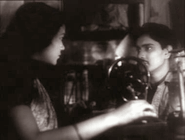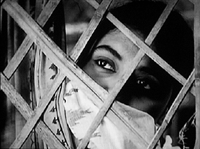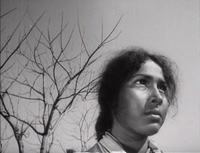 The Citizen, 1952. The opening image of Ritwik Ghatak’s first feature film consists of a steady motion, acute angle dolly shot of mature trees (a symbolic image that is similarly implemented in the introductory sequence of The Cloud-Capped Star) lining an anonymous street, a juxtaposition of transience and permanence that serves as a seeming reflection of the inconstancy and economic uncertainty of contemporary existence for Bengali refugees in post-Partition Calcutta. An ode to a nameless “citizen” is recited against the image of a well-dressed young man, Ramu (Satindra Bhattacharya), dutifully helping an elder stranger cross the street. But the image of prosperity and civic responsibility prove to be an illusion, as Ramu arrives home and returns the suit and shoes that he had borrowed from his ailing father (Kali Bannerjee), a former school teacher, for a job interview, another unrealized prospect for a brighter future that – for the optimistic Ramu – was always just around the corner. Resting their hopes on Ramu’s ability to find a job after investing their eroding fortunes toward earning his college degree, his parents have little hope for a better life for his undereducated sister except to marry her off to anyone who is able to provide for her, indulging the whims of prospective suitors who subject her to humiliating physical inspections and candid assessments of her attractiveness. Chronicling Ramu and his family’s disillusioning, often frustrated empty rituals for economic survival and quest to return to a semblance of a normal life, the film represents an uncharacteristically affirming exposition of Ghatak’s recurring themes (undoubtedly influenced by the film collective nature of the production) of marginalization, poverty, dislocation, and petty self-interest that have contributed to the erosion of Bengali culture. Ghatak supplants the idyllic images of trees (in particular, Ramu’s calendar depicting a red-roofed country house) with the jarring noise of a heavy machinery excavator (in an overlapping cutaway of Ramu at his father’s bedside) in order to introduce (or rather, underscore) a metaphor for the intrusive, violent uprooting of the Partition that has figuratively crippled – and ultimately orphaned – a population. It is within this environment of crushed hopes and unrealized dreams that the father’s blindness and debilitation can be seen, not only as a metaphor for cultural short-sightedness that led to the Partition, but also as a spiritual resignation for their fractured homeland – a unrequited pining for a sentimental lost love. Presaging the idiosyncratic sound strategy of incorporating whiplashes in The Cloud-Capped Star (in a scene that also captures a doomed love), the father’s evocative words, “Each day is like the lash of a storm”, seemingly betrays Ghatak’s own bittersweet articulation of impotence towards a divided Bengal: a despair silenced by the impersonal machinery and the uncontrollable chaos of its own man-made creation.
The Citizen, 1952. The opening image of Ritwik Ghatak’s first feature film consists of a steady motion, acute angle dolly shot of mature trees (a symbolic image that is similarly implemented in the introductory sequence of The Cloud-Capped Star) lining an anonymous street, a juxtaposition of transience and permanence that serves as a seeming reflection of the inconstancy and economic uncertainty of contemporary existence for Bengali refugees in post-Partition Calcutta. An ode to a nameless “citizen” is recited against the image of a well-dressed young man, Ramu (Satindra Bhattacharya), dutifully helping an elder stranger cross the street. But the image of prosperity and civic responsibility prove to be an illusion, as Ramu arrives home and returns the suit and shoes that he had borrowed from his ailing father (Kali Bannerjee), a former school teacher, for a job interview, another unrealized prospect for a brighter future that – for the optimistic Ramu – was always just around the corner. Resting their hopes on Ramu’s ability to find a job after investing their eroding fortunes toward earning his college degree, his parents have little hope for a better life for his undereducated sister except to marry her off to anyone who is able to provide for her, indulging the whims of prospective suitors who subject her to humiliating physical inspections and candid assessments of her attractiveness. Chronicling Ramu and his family’s disillusioning, often frustrated empty rituals for economic survival and quest to return to a semblance of a normal life, the film represents an uncharacteristically affirming exposition of Ghatak’s recurring themes (undoubtedly influenced by the film collective nature of the production) of marginalization, poverty, dislocation, and petty self-interest that have contributed to the erosion of Bengali culture. Ghatak supplants the idyllic images of trees (in particular, Ramu’s calendar depicting a red-roofed country house) with the jarring noise of a heavy machinery excavator (in an overlapping cutaway of Ramu at his father’s bedside) in order to introduce (or rather, underscore) a metaphor for the intrusive, violent uprooting of the Partition that has figuratively crippled – and ultimately orphaned – a population. It is within this environment of crushed hopes and unrealized dreams that the father’s blindness and debilitation can be seen, not only as a metaphor for cultural short-sightedness that led to the Partition, but also as a spiritual resignation for their fractured homeland – a unrequited pining for a sentimental lost love. Presaging the idiosyncratic sound strategy of incorporating whiplashes in The Cloud-Capped Star (in a scene that also captures a doomed love), the father’s evocative words, “Each day is like the lash of a storm”, seemingly betrays Ghatak’s own bittersweet articulation of impotence towards a divided Bengal: a despair silenced by the impersonal machinery and the uncontrollable chaos of its own man-made creation.
 The Cloud-Capped Star, 1960. In an impoverished refugee village in Calcutta, an attractive and industrious young woman, Nita (Supriya Choudhury), breaks a sandal while passing through the market square, and without complaining, continues barefoot on the graveled street, unable to buy a replacement pair of sandals for the walk home. Patently aware that Nita has received her monthly salary, her talented, but indolent older brother Shankar (Anil Chatterjee) pays an unexpected visit, and encountering Nita absorbed in reading a personal letter from a suitor named Sanat (Niranjan Ray), playfully snatches the note and reads aloud its affectionate contents, before asking her for spending money. Meanwhile her younger sister, Gita (Gita Ghatak) and brother Mantu (Dwiju Bhawal) brazenly plead with their desperate and resourceless mother (Gita De) for new articles of clothing, before re-directing their vain and selfish entreaties to Nita. Having spent her entire salary on her burdensome, coddled siblings, her embittered and insecure mother then vociferously complains to her father (Bijon Bhattacharya), an underemployed school teacher, that Nita has squandered the monthly household budget. Bound by a selfless sense of familial duty, Nita has decided to postpone her marriage to Sanat until Shankar realizes his ambition to become a classical singer. However, as Nita perseveres in her sacrifice for her ungrateful and demanding family, her own prospects for happiness proves ever increasingly bleak.
The Cloud-Capped Star, 1960. In an impoverished refugee village in Calcutta, an attractive and industrious young woman, Nita (Supriya Choudhury), breaks a sandal while passing through the market square, and without complaining, continues barefoot on the graveled street, unable to buy a replacement pair of sandals for the walk home. Patently aware that Nita has received her monthly salary, her talented, but indolent older brother Shankar (Anil Chatterjee) pays an unexpected visit, and encountering Nita absorbed in reading a personal letter from a suitor named Sanat (Niranjan Ray), playfully snatches the note and reads aloud its affectionate contents, before asking her for spending money. Meanwhile her younger sister, Gita (Gita Ghatak) and brother Mantu (Dwiju Bhawal) brazenly plead with their desperate and resourceless mother (Gita De) for new articles of clothing, before re-directing their vain and selfish entreaties to Nita. Having spent her entire salary on her burdensome, coddled siblings, her embittered and insecure mother then vociferously complains to her father (Bijon Bhattacharya), an underemployed school teacher, that Nita has squandered the monthly household budget. Bound by a selfless sense of familial duty, Nita has decided to postpone her marriage to Sanat until Shankar realizes his ambition to become a classical singer. However, as Nita perseveres in her sacrifice for her ungrateful and demanding family, her own prospects for happiness proves ever increasingly bleak.
Ritwik Ghatak presents a visually sublime, idiosyncratically overripe, but provocative and deeply personal account of poverty, disillusionment, and exile in The Cloud-Capped Star. By interplaying light and shadows and incorporating evocative, aggressive sounds that underscore emotional impact and comedic tone, Ghatak creates a unique, sensorial experience that chronicles the systematic demoralization of the human soul: the surreal, foreboding shot of Nita descending a staircase after she is compelled to leave her studies in order to support the family; the overemphasized sounds of cooking as the mother spies on Nita and Sanat that aurally conveys her anger and fear at losing their primary source of income; the contrasted image of Nita – first, illuminated in front of a latticed window as she reads Sanat’s letter and later, concealed behind the window after Shankar’s return; the sound of lashing as Nita and Shankar sing a melancholic Rabindranath Tagore song (evoking Raskolnikov’s dream on burden and responsibility in Fyodor Doestoevsky’s Crime and Punishment). An allegory for the traumatic consequences of the partition of Bengal, The Cloud-Capped Star captures the disintegration of a Bengali middle class family as a result of dislocation, poverty, self-interest, and petty, internal division. Note the repeated imagery of a passing train bisecting the horizon that alludes to the physical division of the family’s ancestral homeland. Inevitably, as Nita attempts to recuperate from the ravages of self-denial, want, and exploitation, her cry of anguish becomes an indistinguishable, resonant echo from the lost and irredeemable soul of a displaced and uprooted people.
 A River Called Titas, 1973. The film opens to the eerily desolate yet tranquil sight of a receded river basin as the expressive voice of a traditional folk singer (Dheeraj Uddin Fakir) serenades the mighty Titas River in East Bengal with a soulful ode on the river’s inconstant ebb and flow that manifests its alternately fickle grace, mercy, and wrath towards the local villagers who rely on the river for their humble commerce and survival. At a fishing village near the riverbank, a girl named Basanti prepares for the Maghmandal ritual to commemorate the coming of winter and her passage to maturity as two friends, Kishore and Subol compete for her affection by building a leaf boat in her honor before joining an uncle to embark on their first extended fishing expedition to the village of Ujaninajar. However, fate invariably intercedes when, years later, Kishore (Prabir Mitra), while staying at a distant village to fish, rescues a beautiful young woman named Rajar Jhi (Kabari Choudhury) during a tribal scuffle. Persuaded by a local fisherman to return to the village to meet the tribal elder in order to foster closer economic and social ties between their communities, Kishore soon realizes that the town’s implication of a “binding gift” is an arranged marriage to Rajar Jhi. It is a union that proves to be short-lived when bandits board their boat en route home, and a distraught and inconsolable Kishore becomes mad with grief. Inevitably, the villagers’ inalterable pattern of austerity, despair, and tragedy emerges as the star-crossed Basanti (Rosy Samad), abandoned by her childhood love, is married off to Kishore’s romantic rival Subol, who too is soon lost to the silent, unforgiving waters.
A River Called Titas, 1973. The film opens to the eerily desolate yet tranquil sight of a receded river basin as the expressive voice of a traditional folk singer (Dheeraj Uddin Fakir) serenades the mighty Titas River in East Bengal with a soulful ode on the river’s inconstant ebb and flow that manifests its alternately fickle grace, mercy, and wrath towards the local villagers who rely on the river for their humble commerce and survival. At a fishing village near the riverbank, a girl named Basanti prepares for the Maghmandal ritual to commemorate the coming of winter and her passage to maturity as two friends, Kishore and Subol compete for her affection by building a leaf boat in her honor before joining an uncle to embark on their first extended fishing expedition to the village of Ujaninajar. However, fate invariably intercedes when, years later, Kishore (Prabir Mitra), while staying at a distant village to fish, rescues a beautiful young woman named Rajar Jhi (Kabari Choudhury) during a tribal scuffle. Persuaded by a local fisherman to return to the village to meet the tribal elder in order to foster closer economic and social ties between their communities, Kishore soon realizes that the town’s implication of a “binding gift” is an arranged marriage to Rajar Jhi. It is a union that proves to be short-lived when bandits board their boat en route home, and a distraught and inconsolable Kishore becomes mad with grief. Inevitably, the villagers’ inalterable pattern of austerity, despair, and tragedy emerges as the star-crossed Basanti (Rosy Samad), abandoned by her childhood love, is married off to Kishore’s romantic rival Subol, who too is soon lost to the silent, unforgiving waters.
Adapted from the Bengali novel by Advaita Malo Barman, A River Called Titas is a thoughtful, sincere, and bittersweet chronicle of poverty, obsolescence, cultural identity and erasure. Ritwik Ghatak characteristically integrates visual economy, stylized camerawork, and idiosyncratic lyricism through allusive, traditional folk songs, cyclical environmental (and existential) phenomena, and exaggerated natural rhythms and diegetic sounds that illustrate the inherent correlation between landscape and human ritual (fishing activity, tribal customs, and ceremonial festivals). Moreover, through the childless young widow Basanti, Ghatak parallels the increasing barrenness of the environment – a devastating local catastrophe that is further exacerbated by ongoing petty (and often socially motivated) self-interest and fractured relationships within the community that contribute to the inevitable dissolution of the village – with the seemingly inevitable cultural extinction of the Bengali people as a result of the Partition of Bengal between British India and Pakistan in 1947. (Note the similarity to the emotionally abandoned, self-sacrificing heroine Nita, a displaced Bengali refugee, in Ghatak’s earlier film, The Cloud-Capped Star.) By presenting the trauma and desolation of unnatural crisis and division, the film serves as a passionate and haunting elegy for a dying culture, and a native son’s irreconcilable personal chronicle of loss, melancholy, and resigned, inarticulable rage.
 Reason, Debate and a Story, 1974. A frail, elderly villager seeking shelter from the burning sun inside a makeshift hut stares inexpressively into the camera as a trio of faceless, black-cladded apparitions perform a vibrant, ritualistic dance before him, perhaps in anticipation of the old man’s inevitable death. The dreamlike, surreal episode seemingly provides an allegorical – and intrinsically operatic – framework for the terminally unemployed intellectual, Nilkantha’s (Ritwik Ghatak) gifted, but equally encumbered (and squandered) life. As the story begins, Nilkantha lies abstractedly crumpled on the floor of an empty house under the numbing haze of alcohol as his long-suffering wife Durga (Tripti Mitra) meticulously removes any tangible object, including his prized phonograph records and books, that he may (and undoubtedly will) eventually sell or barter for a drink before leaving with their young son Satya (Ritaban Ghatak) and arranging for the sale of the house in order to start a new life in the rural town of Kanchanpur far away from him. Dispossessed of everything, Nilkantha finds an enabling protector in his former student Nachiketa (Saugata Burman), an engineering university graduate unable to find employment in the uncertain economy and turbulent political landscape of 1970s Calcutta. Sending the obliging Nachiketa on an errand to buy a bottle of liquor (using the house ceiling fan as trading fodder), Nilkantha soon finds himself joined in the empty room by a young woman named Bangabala (Shaonli Mitra), a refugee from newly independent Bangladesh who has entered the home in search of shelter under the mistaken belief that the house had been abandoned. Believing that she is the soul of his beloved homeland and touched by her traumatic plight, Nilkantha takes Bangabala under his wing. Forced to vacate the premises with the arrival of the new owners, the three begin to wander through the streets and, after rescuing an eccentric Sanskrit teacher named Jagannath (Bijon Bhattacharya) who coincidentally hails from his ancestral village, Nilkantha decides to lead his ragtag band of displaced brethren to a journey into the country, away from the cold, impersonal streets of Calcutta, in search of an elusive place called home.
Reason, Debate and a Story, 1974. A frail, elderly villager seeking shelter from the burning sun inside a makeshift hut stares inexpressively into the camera as a trio of faceless, black-cladded apparitions perform a vibrant, ritualistic dance before him, perhaps in anticipation of the old man’s inevitable death. The dreamlike, surreal episode seemingly provides an allegorical – and intrinsically operatic – framework for the terminally unemployed intellectual, Nilkantha’s (Ritwik Ghatak) gifted, but equally encumbered (and squandered) life. As the story begins, Nilkantha lies abstractedly crumpled on the floor of an empty house under the numbing haze of alcohol as his long-suffering wife Durga (Tripti Mitra) meticulously removes any tangible object, including his prized phonograph records and books, that he may (and undoubtedly will) eventually sell or barter for a drink before leaving with their young son Satya (Ritaban Ghatak) and arranging for the sale of the house in order to start a new life in the rural town of Kanchanpur far away from him. Dispossessed of everything, Nilkantha finds an enabling protector in his former student Nachiketa (Saugata Burman), an engineering university graduate unable to find employment in the uncertain economy and turbulent political landscape of 1970s Calcutta. Sending the obliging Nachiketa on an errand to buy a bottle of liquor (using the house ceiling fan as trading fodder), Nilkantha soon finds himself joined in the empty room by a young woman named Bangabala (Shaonli Mitra), a refugee from newly independent Bangladesh who has entered the home in search of shelter under the mistaken belief that the house had been abandoned. Believing that she is the soul of his beloved homeland and touched by her traumatic plight, Nilkantha takes Bangabala under his wing. Forced to vacate the premises with the arrival of the new owners, the three begin to wander through the streets and, after rescuing an eccentric Sanskrit teacher named Jagannath (Bijon Bhattacharya) who coincidentally hails from his ancestral village, Nilkantha decides to lead his ragtag band of displaced brethren to a journey into the country, away from the cold, impersonal streets of Calcutta, in search of an elusive place called home.
Marking the final film by Ritwik Ghatak, Reason, Debate and a Story poignantly (and provocatively) encapsulates the recurring, overarching themes that have come to define the filmmaker’s passionate and indelible cinema: dislocation, exile, factionalism, division, cultural dissolution. From the opening sequence of marital separation (and Nilkantha’s subsequent eviction from home), Ghatak provides an intrinsically personal, allegorical framework to the sequence of traumatic history that have plagued the Bengali people (and culture) throughout the course of the twentieth century: the man-made Famine of Bengal in 1943 that decimated communities and ushered a wave of refugees struggling to survive, the Partition of Bengal in 1947 between India and Pakistan that further caused the forcible uprooting of families from their native homeland (often resettling in Calcutta in search of economic opportunity), the struggle for independence from Pakistan in East Bengal that led to the creation of the separate nation of Bangladesh (and further dissipating any hopes for the reunification of the two Bengals), the rampancy of political agitation from the contemporary Naxalite movement as insurgents strive to incite a peasant revolution (and consequently, land reform) throughout the region. By incorporating his own personal struggle with alcoholism into the story, Ghatak provides, not only a semi-autobiographical context to Nilkantha’s travails, but more importantly, introduces the idea of self-inflicted destruction that, in turn, serves as an allegory for the Bengali people’s own complicity in the dissolution of their homeland and culture through petty self-interest, abandoned ideology (note Nilkantha’s encounter with the former intellectual turned underground pornographic novelist, Shatrujit (Utpal Dutt) in an open field), and resigned complacency. It is this acceptance of individual human frailty in the face of a formidable social struggle that is reflected in Nilkantha’s comment, “Somewhere, at some new day, we shall learn that slipping is not death”, a sentiment of untiring activism and defiance against the extinguishing of a humble ideal – a unified homeland – that is reflected in his faltering words to his beloved wife Durga, “I have to do something, don’t I? I have to do something.”
Acquarello 2002-2005 [reprinted]